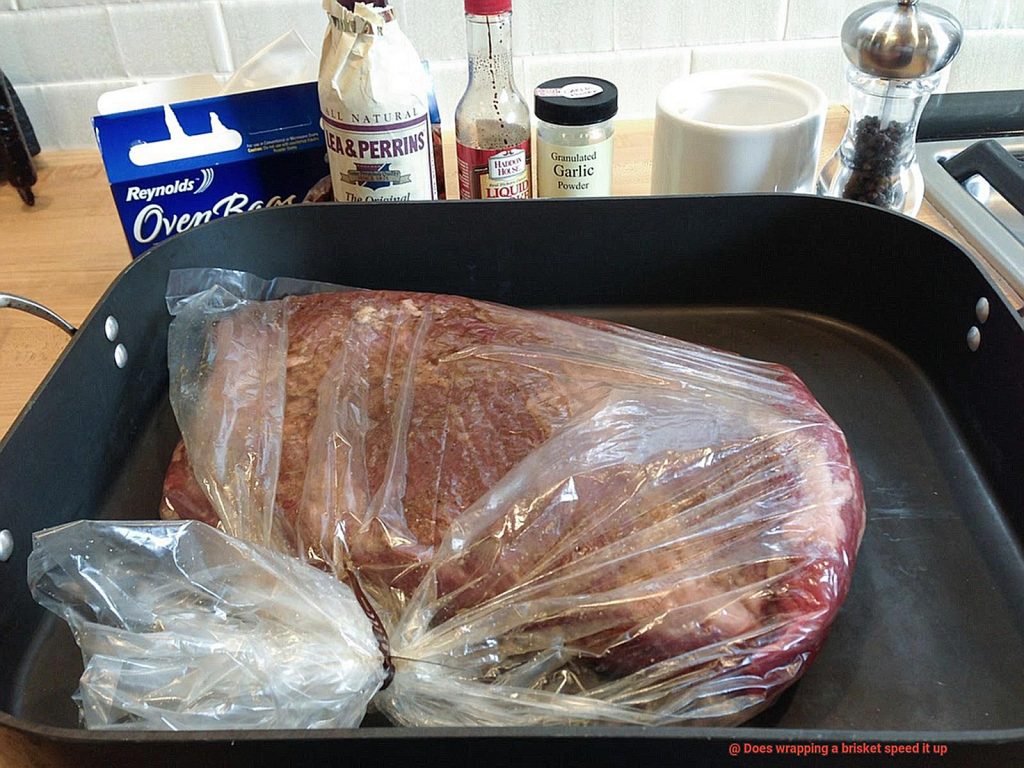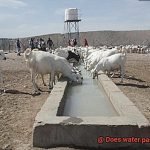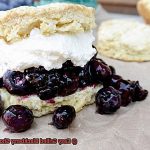Are you a barbecue fanatic on a quest for that elusive, melt-in-your-mouth brisket perfection? Well, my friend, prepare to have your taste buds tantalized and your grilling world turned upside down. Today, we’re diving headfirst into the fiery debate that has sparked passionate backyard discussions for years: does wrapping a brisket actually speed up the cooking process?
This question has divided pitmasters and grill enthusiasts alike. Some swear by the mystical powers of wrapping – whether it’s aluminum foil or trusty butcher paper – claiming it shaves off precious cooking time while preserving tenderness and flavor. Others argue vehemently that it’s all just smoke and mirrors, insisting that true barbecue nirvana can only be achieved through unwrapped patience and low temperatures.
In this comprehensive exploration, we’ll delve deep into the scientific foundations and expert opinions surrounding the impact of wrapping on brisket cook time. We’ll uncover how this technique affects tenderness, moisture retention, and that coveted smoky bark formation. So grab your smoker or fire up your humble backyard grill because it’s time to unlock the secrets behind achieving brisket perfection in record time.
Join us as we separate fact from fiction and equip you with the knowledge to take your barbecue game to new heights. Get ready to settle the debate once and for all – does wrapping a brisket truly speed up the cooking process or is it just a sizzling smokescreen?
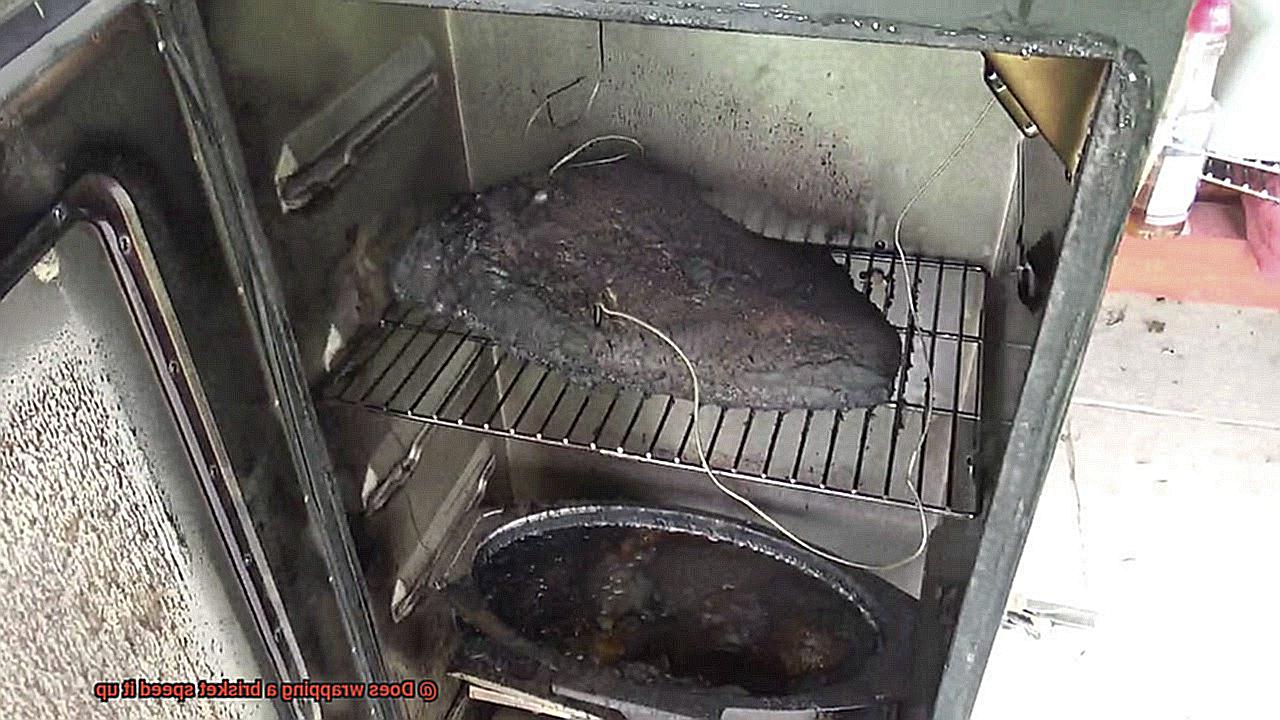
Contents
What is Wrapping a Brisket?
Enter the world of barbecue, where the smoky aroma and mouthwatering flavors of brisket reign supreme. Among the techniques cherished by pitmasters, wrapping the brisket during the cooking process has emerged as a game-changer. In this article, we will delve into the intricacies of wrapping a brisket, how it transforms the cooking process, and why it is an indispensable step in achieving tender and succulent results.
Picture this: after hours of slow smoking, your brisket hits a temperature plateau known as the “stall.” This is when wrapping enters the scene. Wrapping involves encasing the brisket tightly in either aluminum foil or butcher paper, creating a cocoon-like environment that traps moisture and heat.
Benefits of Wrapping:
Wrap your brisket, and magic unfolds. The advantages are manifold:
- Unleashes the Texas crutch effect, accelerating the cooking process.
- Locks in precious moisture for a luscious and flavorful end product.
- Tenderizes the meat by artfully breaking down collagen and connective tissues.
- Exerts control over bark development, preventing over-darkening or burning.
Materials for Wrapping:
The choice of wrapping material is a matter of personal preference and desired outcome:
- Aluminum foil: Create an hermetic seal that keeps moisture and heat tightly locked in.
- Butcher paper: Embrace airflow while lending insulation for a distinctive texture and flavor profile.
Finding the Perfect Balance:
A delicate equilibrium lies at the heart of wrapping a brisket:
- Smokiness factor: Longer unwrapped intervals result in deeper smoke flavor absorption.
- Personal experimentation: Discover your ideal balance between smoke infusion and other flavor elements.
Expert Tips for Wrapping Success:
Elevate your wrapping finesse with these pointers:
- Opt for heavy-duty aluminum foil or uncoated butcher paper to ensure durability.
- Achieve a tight seal to prevent steam or smoke from escaping.
- Regularly monitor the internal temperature to avoid overcooking.
Does Wrapping a Brisket Speed Up the Cooking Time?
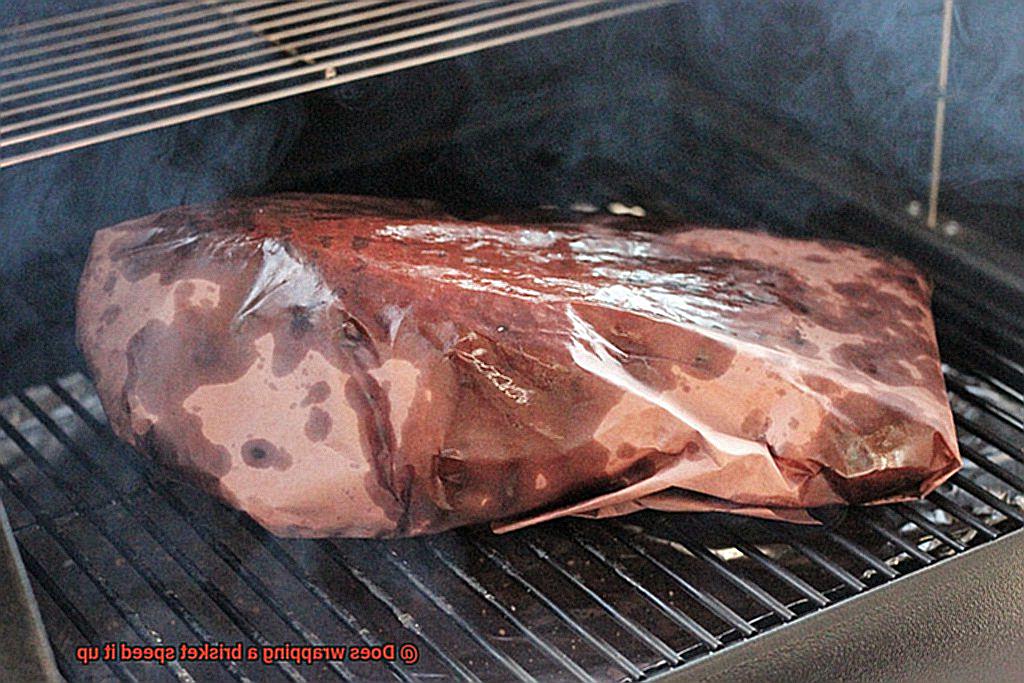
Perfectly cooked brisket is the holy grail of grilling – tender, juicy, and bursting with flavor. Pitmasters have spent centuries perfecting the art of brisket smoking, and one technique that has gained popularity is wrapping the brisket in foil or butcher paper. But does this method really speed up the cooking time? And what impact does it have on the texture? Let’s delve into the research to find out.
Efficiency Factor:
One of the benefits of wrapping a brisket is creating a more efficient cooking environment. By retaining heat and moisture, wrapping allows for faster and more even cooking. This means you can enjoy a mouthwatering brisket in less time.
Tenderizing Magic:
The wrapping process serves as a tenderizing agent by trapping natural juices and steam. As the brisket cooks, these liquids break down tough connective tissues, resulting in a melt-in-your-mouth texture and incredible flavor.
Bye-bye Dryness:
Nobody wants a dry brisket, and wrapping ensures that doesn’t happen. The tight seal created by foil or butcher paper locks in moisture, preventing it from evaporating during cooking.
Fat is Your Friend:
Rendering fat is crucial for achieving a delicious brisket, and wrapping helps accelerate this process. By keeping the fat close to the meat, it can penetrate and baste the brisket, adding flavor and moisture.
The Bark Dilemma:
While wrapping can speed up cooking time and improve tenderness, it does have its drawbacks. Wrapping can soften and moisten the bark – that flavorful crust we all love – making it less crispy and chewy compared to unwrapped brisket.
The Wrap Battle:
Different wrapping materials have varying effects on cooking time and bark development. Foil provides a tight seal and retains more moisture, resulting in faster cooking. On the other hand, butcher paper allows for more airflow, creating a better bark while still retaining some moisture.
Personal Preference:
Ultimately, whether to wrap or not depends on your desired outcome. Wrapping is ideal for achieving tender, juicy brisket in a shorter amount of time. However, some pitmasters prefer the firm bark and smokier flavor achieved without wrapping.
The Pros and Cons of Wrapping a Brisket
Brisket, the king of barbecue, is a low-and-slow cooking masterpiece. But should you wrap it in foil or butcher paper during the cooking process? In this article, we’ll explore the pros and cons of wrapping a brisket, so you can make an informed decision for your next grilling adventure.
Advantages of Wrapping a Brisket:
- Faster Cooking Time: Wrapping your brisket helps retain heat and moisture, resulting in a faster and more even cooking process. No more waiting around for hours on end.
- Tenderizing Magic: Wrapping breaks down connective tissues, transforming tough meat into a juicy, melt-in-your-mouth delicacy.
- Flavorful Bark: The wrapped environment creates the perfect conditions for a mouthwatering bark to develop on the outside of your brisket. This flavorful crust adds texture and taste to every bite.
- Controlled Smoke Absorption: Wrapping prevents your brisket from becoming overly smoky. It allows just the right amount of smoke flavor to infuse the meat without overpowering other flavors.
Disadvantages of Wrapping a Brisket:
- Softened Bark: Wrapping traps moisture, resulting in a softer bark instead of that coveted crispy crust. If you’re all about that crunch, reconsider your wrapping technique.
- Reduced Smoke Penetration: Wrapped briskets are shielded from direct smoke exposure, potentially leading to a milder smoky flavor compared to unwrapped counterparts.
- Limited Seasoning Opportunities: Once wrapped, accessing the meat to add seasoning or mop sauces becomes challenging without disturbing the cooking environment.
- Potential Flavor Complexity Loss: Some pitmasters argue that wrapping can hinder the intricate interplay between meat, smoke, and seasonings, resulting in a less nuanced flavor profile.
What is the Texas Crutch?
The Texas Crutch is a technique used by pitmasters in Texas to take their barbecue game to the next level. By wrapping the meat tightly in either foil or butcher paper during the cooking process, this simple step can transform a good brisket into a mouthwateringly great one.
The Texas Crutch offers several advantages that make it a popular technique among barbecue enthusiasts. First and foremost, wrapping the brisket creates a seal that retains moisture, preventing it from evaporating. This helps keep the meat juicy throughout the long cooking process. In addition, the heat is distributed more evenly when the brisket is wrapped, resulting in faster cooking times. This is especially beneficial for large cuts of meat like brisket, which traditionally take hours to cook.
One of the key benefits of the Texas Crutch is its ability to tenderize tough cuts of meat. The combination of wrapping and cooking at a slightly higher temperature helps break down collagen and connective tissues in the meat, resulting in a melt-in-your-mouth texture.
However, it’s important to consider the drawbacks of using the Texas Crutch as well. When wrapped tightly, moisture can hinder the development of a crispy bark, which is highly desired by many barbecue enthusiasts. Additionally, some pitmasters argue that wrapping the meat limits smoke penetration, resulting in a milder smoky flavor.
How Does Wrapping Affect Bark Formation and Smoke Penetration?
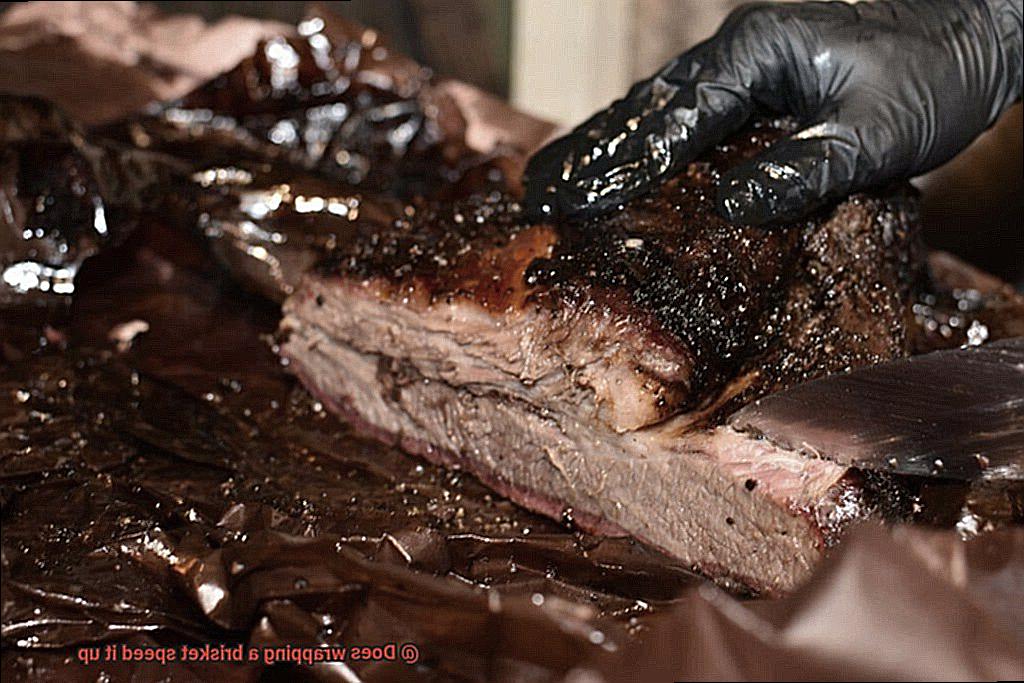
The age-old debate of whether to wrap or not to wrap your brisket during the smoking process has pitmasters fired up. Bark formation, that delectable crust on the outside of the brisket, is the holy grail of barbecue. It’s what adds that mouthwatering flavor and texture to every bite. But does wrapping affect bark formation? Let’s dive in and find out.
When you wrap a brisket, you create a moist environment inside the wrapping. This can soften the bark and make it less crispy. Sacrificing that satisfying crunch may not be worth it for those grillers who crave that perfect bark. However, fear not, my friends. Wrapping does have its benefits.
By creating a seal around the meat, wrapping helps retain moisture, resulting in a tender and juicy final product. No one wants a dry brisket, right? Wrapping can be a game-changer for achieving that melt-in-your-mouth texture we all yearn for. But here’s the catch: the moisture trapped inside the wrapping can also prevent smoke from fully penetrating the meat.
That smoky flavor is what makes barbecue so irresistible. So if you’re all about that intense smokiness, wrapping might not be your best bet. Foil wrapping tends to produce a softer bark and less smoke penetration compared to butcher paper or no wrapping at all.
In the end, whether to wrap or not to wrap depends on your personal preferences as a pitmaster. Some of us are willing to sacrifice a bit of bark crispiness for tenderness and moisture, while others prioritize that perfect bark above all else. It’s a journey of barbecue exploration, my friends.
Experimentation is key when finding your perfect brisket technique. Try different methods and timings to see what works best for you. There’s no one-size-fits-all approach to barbecue mastery, so don’t be afraid to get creative and find your own unique style.
Low and Slow Cooking for Tenderness
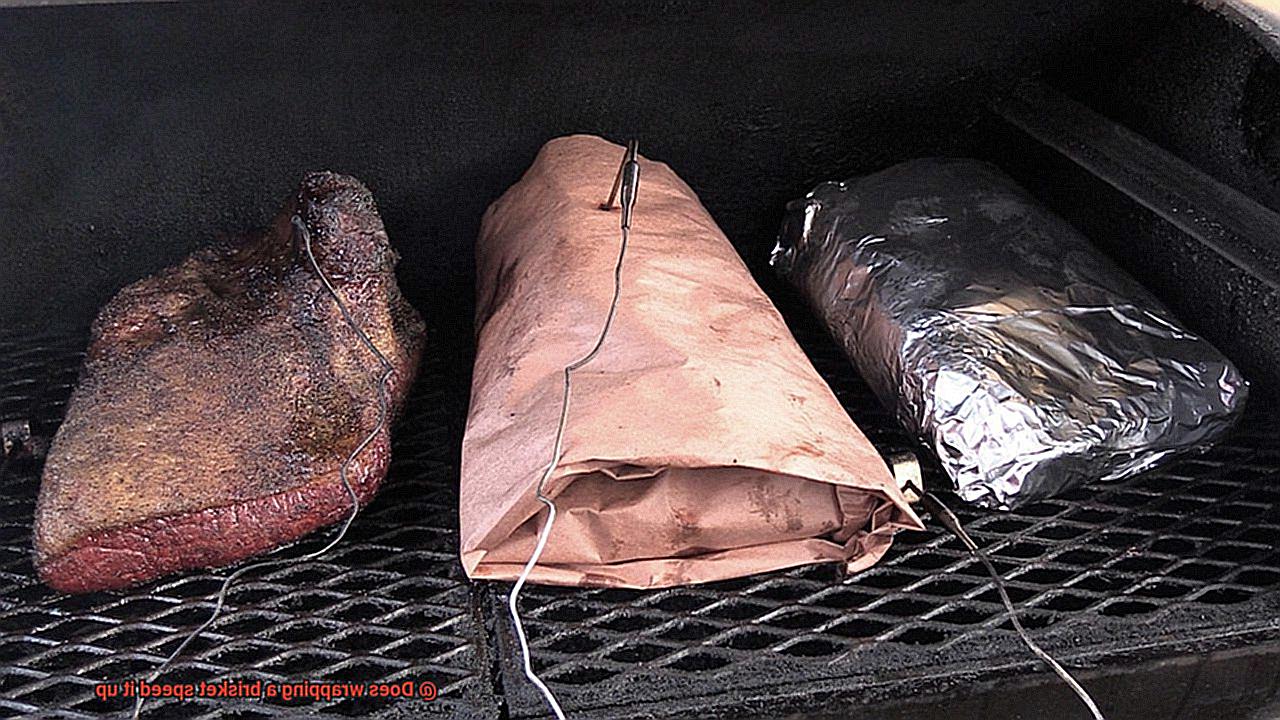
This method is all about patience and allowing the magic to happen over time. So grab a cold one, sit back, and let me break it down for you.
The low and slow cooking method is all about cooking meats at a low temperature over a long period of time. It’s like a slow dance between heat and meat, where the collagen in tough cuts like brisket breaks down slowly, resulting in a tender, juicy masterpiece.
But here’s the kicker: you need indirect heat to achieve that tender perfection. Whether you’re using a smoker, a grill with indirect heat capabilities, or even an oven, maintaining a consistent temperature is crucial. It’s like creating the perfect environment for your brisket to work its magic.
Now, let’s talk wrapping. Wrapping your brisket can be a game-changer. It helps to lock in moisture and can even speed up the cooking time. Foil or butcher paper are popular choices for wrapping, creating a more humid environment that prevents your precious meat from drying out. But hold on now, because some pitmasters prefer to cook their briskets unwrapped. Why? Well, it’s all about that glorious bark – that flavorful crust that develops on the exterior of the meat. Cooking unwrapped allows for more time to develop that bark, adding an extra layer of deliciousness.
But wait, there’s more. If you’re feeling adventurous, you can try the Texas crutch method. This involves wrapping your brisket in foil with some liquid like beef broth or apple juice during the cooking process. The steam created inside the foil helps to tenderize the meat and can result in a faster cooking time. Just be careful not to overcook and end up with mushy meat.
Is Wrapping Necessary for Moisture Retention?
For grill masters and pitmasters, achieving the perfect brisket is a true labor of love. In the barbecue world, there is an ongoing debate about whether or not to wrap your brisket for moisture retention. Let’s explore the advantages and disadvantages of wrapping and help you make an informed decision.
Advantages of Wrapping:
- Moisture Retention: Wrapping your brisket in foil or butcher paper creates a steamy environment that traps moisture, preventing it from evaporating. The result? A juicy and tender end product that will have your taste buds dancing with delight.
- Faster Cooking Time: Wrapping can actually speed up the cooking process by tenderizing the meat faster. The trapped moisture and steam break down collagen, reducing the cooking time and allowing you to savor that mouthwatering brisket sooner.
- Tender and Juicy Brisket: Wrapping helps to maintain the moisture levels in your brisket, ensuring it stays juicy throughout the cooking process. Say goodbye to dry and disappointing results.
Disadvantages of Wrapping:
- Soft Bark or Soggy Texture: If you wrap your brisket too early, you may sacrifice the formation of a desirable bark on the outside. The bark is a flavorful crust that adds a delicious smoky taste to your brisket. Wrapping prematurely can result in a softer bark or even a soggy texture.
- Temperature Monitoring: When you choose to wrap your brisket, be prepared for it to cook faster than expected. Keep a close eye on the internal temperature to avoid overcooking and disappointment.
- Personal Preference: Ultimately, the decision to wrap your brisket depends on personal preference and desired outcome. Some pitmasters prefer to cook their briskets unwrapped for most of the time to allow for proper bark formation.
Experimentation for the Perfect Texture, Moisture, and Flavor
Experimentation is key in the quest for the perfect texture, moisture, and flavor in a brisket. Grill enthusiasts are constantly wondering if wrapping their briskets can speed up the cooking time without sacrificing the desired qualities of the meat. Let’s dive into the research and find out.
To test the impact of wrapping a brisket, one approach involves cooking two identical cuts of meat side by side. One brisket remains unwrapped throughout the entire cooking process, while the other is tightly wrapped in aluminum foil after a certain amount of time. By comparing the results, we can determine if wrapping truly speeds up the cooking time.
But what about different types of wraps? Another experiment involves using various materials such as butcher paper, peach paper, and aluminum foil to wrap different briskets. All briskets are cooked under the same conditions to compare how each wrap affects texture, moisture, and flavor.
To ensure accurate results, it’s crucial to control other variables like temperature and cooking time. A reliable thermometer is used to monitor the internal temperature of the briskets, and they are all cooked for the same amount of time at a consistent heat level.
And let’s not forget about taste. Blind taste tests with a panel of judges provide valuable insights into how wrapping affects flavor. Judges evaluate each brisket based on tenderness, juiciness, and overall taste. This feedback helps determine if wrapping truly enhances or detracts from the desired qualities of a perfectly cooked brisket.
Conclusion
In conclusion, the wrapping debate surrounding brisket speed has ignited passionate discussions among pitmasters and barbecue enthusiasts. After diving deep into the scientific foundations and expert opinions on this technique, we can draw a few key conclusions.
Without a doubt, wrapping a brisket holds the potential to accelerate cooking time. By creating a hermetically sealed environment using either aluminum foil or butcher paper, heat becomes trapped, resulting in faster and more evenly cooked meat. This proves advantageous when you’re yearning to sink your teeth into that tantalizing brisket sooner rather than later.
Furthermore, wrapping aids in moisture retention, yielding an end product that is tender and succulent. The tight seal prevents the meat from drying out during the lengthy cooking process, ensuring each bite bursts with juicy goodness.
Nevertheless, it’s crucial to consider the downsides of wrapping as well. The act of wrapping can soften and moisten the bark – that delectable crust encasing the exterior of the brisket – diminishing its desired crispiness and chewiness compared to unwrapped counterparts. If achieving a perfect bark ranks high on your priority list, it may be worth reevaluating your wrapping technique.
Ultimately, whether to wrap or not boils down to personal preference and desired outcome. Some pitmasters swear by wrapping due to its efficiency and ability to produce tender results, while others relish in the firm bark and smokier flavor achieved without any wrappings.
The key takeaway here is experimentation. Embark on a culinary adventure by trying different methods and timings until you uncover what works best for you. There’s no universal formula for achieving brisket perfection – it’s all about discovering your own distinctive style and honing your mastery of barbecue techniques.

